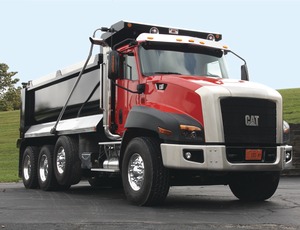Navistar Makes U-Turn on Diesel Engines, Arrives at Cummins

Navistar International Corp. is abandoning its decade-long Class 8 diesel-truck-engine strategy and turning to rival and onetime supplier Cummins Inc. for a viable solution. The move marks a setback for the Lisle, Ill.-based Navistar, which had been bullish about exhaust-gas-recirculation, or EGR, its in-cylinder technology worth about $700 million in development costs since 2001. The truck engines still do not meet Environmental Protection Agency standards that went into effect in 2010.
Cummins, by contrast, uses selective-catalytic reduction (SCR), a clean-air technology that requires drivers to fill up a tank of urea periodically to neutralize nitrogen-oxides (NOx) in the tailpipe. The Columbus, Ind.-based firm has a nearly 40% heavy-duty truck-engine market share. Fuel economy gains of up to 5% are one reason why Cummins and other manufacturers have adopted SCR.
Navistar now plans to combine its 13-liter MaxxForce engines with Cummins' aftertreatment starting in early 2013, with a 15-liter version to follow.
Caterpillar Trucks
In addition to its own product line, the move will impact Navistar's supply deals, such as its agreement to produce vocational trucks for Peoria, Ill.-based Caterpillar. "Caterpillar will continue to sell and ship Cat vocational trucks with engines that meet EPA regulatory requirements," says Jim Dugan, Cat spokesman, in an e-mailed statement. "Navistar is our valued engine supplier, and the company continues to supply us with quality, compliant engines."
With similar themes, a memo obtained by ENR and sent by Cat to its dealers on July 6 reassured them the engines would meet regulatory requirements. EPA has been less generous in its praise of Navistar, despite licensing an EGR engine technology to the company that has not yet met EPA's own emission regulations.
"Substantial work was required to meet the current standard, and Navistar was a 'technological laggard,' " EPA said in a recent court pleading.
Navistar, the country's third-largest heavy-duty truck seller, has been using EPA pollution credits and paying penalties of $1,919 per non-compliant engine to meet the 2010 NOx standard. Navistar expects an adjusted pretax third-quarter loss of $105 million to $145 million, the company says in a statement. Navistar already has reported two straight quarterly losses this year.
The use of such credits has rankled competitors who sued the EPA earlier this year. A U.S. Court of Appeals in Washington, D.C., threw out an EPA interim rule on June 12 that allowed Navistar to sell non-compliant engines in exchange for the fines.
False Expectations
Navistar has long contended that SCR is a hassle for fleet owners and easy for scofflaws to defeat. Its EGR strategy aimed to capture a part of the market that didn't want to deal with SCR and urea.
"In the near term, Navistar could actually do reasonably well with its EGR engine, as there are customers who prefer to avoid urea," says J.P Morgan analyst Ann Duignan in a recent investor note. "Additionally, the fear of a redundant or stranded engine technology is less of an issue since Navistar will continue to offer the same basic engine with Cummins SCR components."
Navistar in 2009 claimed that 13-liter engines were sufficient to cover nearly 80% of the Class 8 market. "The company hoped to convert roughly 60% of its 15-liter customers into [using] 13-liter engines," explains Morningstar analyst Basili Alukos in an investor note. "[Navistar] believed it would only alienate 20% of the industry without a 15-liter engine. Clearly, this expectation was false."
Navistar on Aug. 2 announced a U.S. Securities and Exchange Commission investigation of company "accounting and disclosure matters" from November 2010 to the present. On the upside, Navistar has attained a five-year, $1-billion loan from a group of banks led by JP Morgan Chase and Goldman Sachs to aid the company through its rough patch.